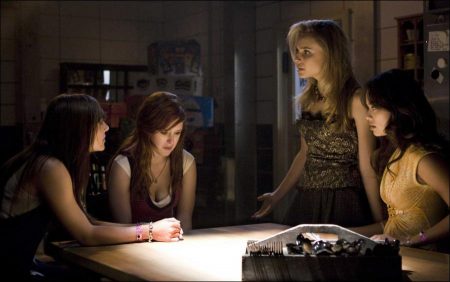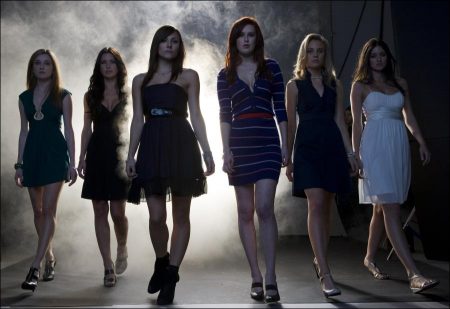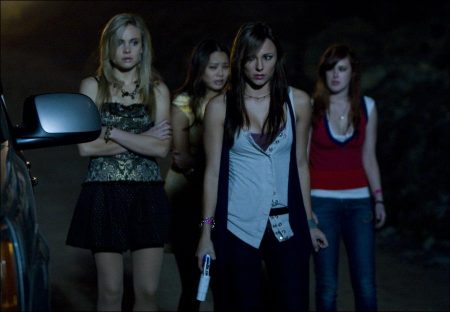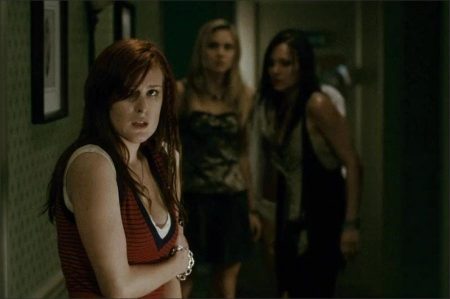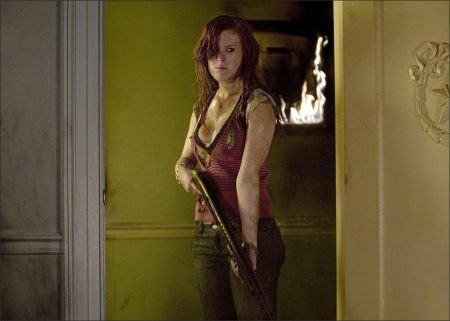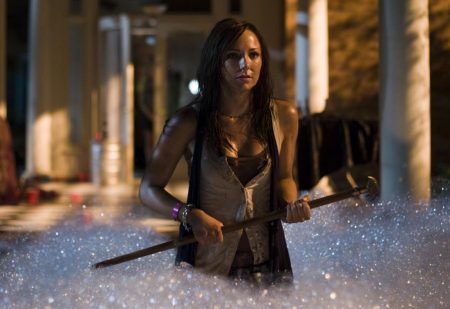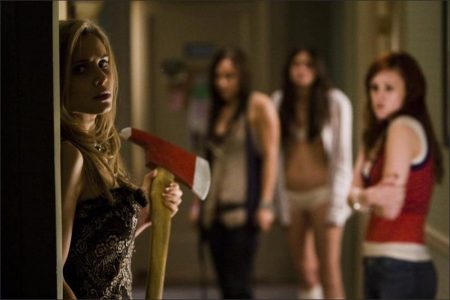Sorority Row Movie Trailer. In 1983, first-time filmmaker Mark Rosman wrote Seven Sisters, a startling new horror screenplay that would go on to become the surprising box office success: House on Sorority Row. Rosman then became a sought after television and feature writer-director, leaving his first project to the vaults until his screenplay would be rediscovered by producers Mike Karz and Darrin Holender.
“The original story was part of a library of films my father was licensing and distributing around the world,” said Darrin Holender. “And this one, I thought, had great potential for a remake.” Holender showed the catalogue to friend and producer Mike Karz.
“It caught my attention,” said Mike Karz. “I had remembered it because another friend, Mark Rosman, who directed a movie I produced called Model Behavior, had created the original..”
Mike Karz had just worked with screenwriter Josh Stolberg on Good Luck Chuck and thought he and on-and-off collaborator Peter Goldfinger might combine well to create a new story based on the original screenplay. One stipulation was that more humor be injected into the basic horror premise.
“Looking at the horror genre of the past few years, I basically made the decision that it had become too edgy and hard with films like Saw and Hostel,” explained Mike Karz. “The writers and I bet the genre would circle back as it often does. When they started reshaping Seven Sisters, they did so to make it something that still delivers the shocks to the fans but also supplies a more character-driven and humorous take on the subject of sororities. Josh and Pete are very funny guys, and we all saw some opportunities for humor in the modern college environment.”
The screenwriters went about creating a re-imagined version of Mark Rosman’s original story, updating it while retaining some of the original’s framework. “The original story was written twenty-six years ago,” said screenwriter Josh Stolberg. “The girls have changed. The morals have changed. We wanted to keep the essence and spirit of Mark’s story, but also create something uniquely our own.”
The new version pleased not only the producers, but original filmmaker Mark Rosman as well. “The new film features a central prank as my film did,” said Mark Rosman. “But instead of the housemother accidentally dying, the victim became a sorority sister. What they retained in the new version was the very contemporary idea of the sisters pulling a prank and having it go awry, keeping them feeling culpable and then being killed for their crime. But that is just the new film’s launching point, as they go a direction that is both more violent as well as more humorous than my film.”
Once the script was written, director Stewart Hendler read it and signed on immediately to guide the project. “The big thing that drew me to the film was its character development,” said Hendler, who had also directed the suspense thriller Whisper. “So many recent horror films start the slashing and killing right away, torturing characters no one can possibly get to know amid the gore and violence. In our film, we spend the first twenty minutes getting to know our characters before anything happens. I think today’s audiences are ready to see a film like this that goes back to the heart and soul of horror movies, which are supposed to be fun!”
The Casting Sessions
With the script locked in and approved by Summit Entertainment, the filmmakers turned their attentions to what they felt the most important aspect would be: casting. “We liked the idea that each of our main girls would be an archetype, if you will,” said Mike Karz. “There’s Jessica, the cool, bitchy blonde who runs the sorority. And Claire, the girl who so badly wants to be Jessica that she follows her blindly. Ellie is the really smart one who usually makes the right decision, but is always quite nervous about life in general. Chugs is the party girl, who just doesn’t care what anyone thinks about her. And finally, there is Cassidy – the moral compass of the story who always treats others well and who has the biggest crisis of conscience over the tragic decisions they come to make.”
Director Stewart Hendler thought the actresses chosen for ‘Cassidy’ and ‘Jessica’ should be strong enough to adequately mirror their characters’ colossal battle of conscience and will. “The best dynamics in the film would come from the butting of heads between Jessica, the ‘Queen Bee’ of the sorority, and Cassidy, its most grounded and decent member. Jessica has planned her life out and won’t let anyone get in the way of getting what she wants. Cassidy, on the other hand, is appalled by Jessica’s attitude and fights her all the way through the film.”
Briana Evigan, who had turned in a strong and athletic performance as hip-hop dancer ‘Andie’ in the popular film Step Up 2:The Streets, was chosen to play Cassidy. “Briana possesses that sort of tough, streetwise feel she had shown in her earlier film,” said Stewart Hendler. “She came in with a non-conformist energy as well as a gritty athleticism we felt the part needed. The script had plenty of action for her to perform, and we thought she could carry that. As it turned out, it was unbelievable to watch Briana work.”
Winning the role of Cassidy appealed to Briana Evigan because the character was strong and resourceful, a person she identified with in real life. “When I read the character of Cassidy, I kept saying to myself ‘I really like her’. She is the strong, confident person that I also tend to be in my life, or at least I try to be every day,” said Briana Evigan. “Out of all the girls, she stood out as the smart one with her head put on right. But I also looked forward to doing the stunts. That would always be the most fun part of my day.”
For the part of Jessica, the filmmakers would turn to an actress not as well known as Briana Evigan but who also possessed a high level of performance paired with attitude: relative newcomer Leah Pipes. The youngest of the actresses chosen for the film, she was already a seasoned veteran of television roles who was just starting to make the step into motion pictures having just starred in small horror film herself, Fingerprints, which had won as Best Picture at the recent NYC Horror Film Festival.
“Leah Pipes has been the big discovery for us all,” said Mike Karz. “Although she had the least film experience going in, she was a great choice. She was so charismatic, taking the role and making it larger than life.”
The actress, who had heretofore been cast as the “good girl” in most of her roles, relished the opportunity to get to play someone with a darker edge. “Jessica is mean and self-centered to an extreme,” said Leah Pipes. “She can almost be a parody of a person. But this can also yield a lot of humor and make her fun to explore. Playing her would help me see outside of being the ‘goody-two-shoes’ I often play to looking at the world through the perspective of a truly evil person.”
For the character of Ellie, the filmmakers had an agenda: not only would the actress chosen for the role have to be a seasoned performer, but she would have to possess something any good horror movie needs – a bloodcurdling scream.
“Rumer Willis turned out to be perfect for Ellie, though the character was far from what she is in real life. Ellie is scared and petrified most of the time, while Rumer is always naturally happy and joking on set,” said Mike Karz. “But once she got into character, she has more cries and screams per minute than anyone in the movie.”
“Some girls can scream and some cannot,” explained Stewart Hendler. “Rumer Willis is definitely the cream of the crop. She would go on to scare many a crew member with that scream when we shot the film.”
After winning the role, Rumer Willis actually researched some celebrated screamers of the past in horror films she admired to get a feel for what would be needed. “I definitely worked on my scream a bit,” said Willis. “You have to practice in order to make sure it sounds real. One example I studied was Neve Campbell’s scream in the Scream films. It is like a double-toned scream, very impressive. It is a lot harder than it looks.”
Jamie Chung was another actress whose beauty paired well with the physical demands the stunts in Sorority Row would place upon her. Having displayed her ability to handle in such films as Dragonball, the role of Claire would be business as usual for the young actress.
“Jamie Chung is one of the most gorgeous girls I’ve ever seen,” said Stewart Hendler. “And I had seen her kick some ass on television in ‘Samurai Girl’. She came in to read and instantly fit into the dynamic of the sorority group in terms of her looks and presence.”
For Jamie Chung, the challenge of playing Claire was the character’s mid-film switch from being Jessica’s sycophant to wanting what is best for others. “Claire is a girl who just wants to fit in,” explained Jamie Chung. “At Theta Pi, all she wants is to be like Jessica. She starts out going with the flow and towards the end of the film you see her going through a transition into being a goodhearted person with the plight of others in mind. It was nice to win a role that had this much growth in it.”
For the party-hardy character of Chugs, screenwriters Josh Stolberg and Peter Goldfinger had envisioned initially casting a larger, louder actress than the petite Margo Harshman.
“We first thought the Chugs character would be a sort of plus-size girl, big and bawdy and loud,” said Josh Stolberg. “When Margo came in to read, she had a totally different take. It was standoffish and dry-humored, completely opposite of what Chugs would be. And it totally worked!”
“Margo came in and nailed the character,” added Stewart Hendler. “She loved the humor, she loved the joke and she blew us away in the audition.”
One aspect of Margo Harshman’s career that appealed to producer Mike Karz was the actress’ strongly professional demeanor, honed by her many years as a young television star on such series as “Even Stevens”. “I like the idea of kids who have grown up acting,” said Mike Karz, “because they are always so prepared and never daunted by anything. Margo is a huge professional. This part was to be a cakewalk for her compared to doing a television series.”
“I just liked the fact that Chugs had an attitude,” said Margo Harshman. “She’s bold, she’s blunt, she’s honest and maybe a bit vulgar, which I loved. I love doing comedy, and the comic aspect of her life drew her to me instantly.”
In choosing two actresses to play look alike siblings Megan and Maggie, a duo of relative newcomers with television backgrounds were selected. As Megan, the ill-fated victim of the sorority’s prank, celebrity sensation Audrina Patridge (star of the top-rated MTV series, “The Hills”) would be able to create a character in a genre she had always enjoyed – horror.
“I love horror movies,” said Audrina Patridge. “The Exorcist is one of the scariest movies ever made. I am also a huge fan of films like Scream and Jawbreaker, which are more like Sorority Row. I was thrilled to play a role where I got to spit up blood and cough and convulse. I had a great time getting into character and preparing to make what happened to Megan look as real and horrific as I could.”
“Audrina was a nice surprise for us,” said producer Mike Karz. “She turned out to be such a trouper, never complaining through most of her scenes, which were shot in cold weather in very skimpy outfits. She impressed everyone.”
“We had just seen Caroline in an episode of ‘Entourage,” said Mike Karz. “We felt she had the bitchiness to stand up to Jessica in our film, but also the ability to have the audience feel empathy for her as well. She far exceeded our expectations for the character and really made it her own.”
A veteran actress would be sought for the pivotal role of housemother ‘Mrs. Crenshaw’, a character who would be called upon to be a bit boozy, a bit overbearing and, ultimately, handy with a shotgun. Only one actress came to mind: Carrie Fisher. “We wanted to have someone fun, someone who we wanted wielding a shotgun and kicking ass,” said Stewart Hendler. “But we thought we’d never have a chance to get her interested.”
Once the actress was sent the script, she insisted on meeting the director alone to discuss his view of the film. “We never thought we could get Carrie,” said Mike Karz. “But once she met with Stewart, she said ‘I like this guy…I’ll do the movie.’ And we were off to shoot. She was so much fun to work with and the girls loved her.”
For Carrie Fisher, the role was attractive for many reasons, despite the fact she would be playing with so many young stars. “I am about twenty-five years older than all of these girls,” said Carrie Fisher. “So that’s a horror film for me in a sense. Poor Mrs. Crenshaw has had a sad life. I think Mr. Crenshaw left her for a younger sorority girl and she didn’t have any children, so the sorority is her family. I enjoy ending up the film as a badass. Somehow this housemother learns to handle a double-barreled shotgun, but that was old hat for me. I had taken lessons before, and got some more on this film just to make sure. After all, I shot a lot of guns in Star Wars and The Blues Brothers.”
Shooting The Film: A Walk Down “Sorority Row”
The first important step once the key cast had arrived in Pittsburgh was creating a bond that would carry through to being true sorority sisters. Director Stewart Hendler made sure the women were all housed in the same downtown hotel, and brought them together after rehearsals for dinners and outings to foster a sense of family.
“Stewart is amazing,” said Mike Karz. “He had the cast come a week early for rehearsals, which turned out to be the smartest thing we did because they spent a week together living as they would at a sorority. They would go off to museums and meals and hang out with each other, so that by the end of that week, they were really a sorority themselves.”
Many of the actresses were accomplished musicians, such as Rumer Willis, Briana Evigan and Margo Harshman. Often the group would end up at the hotel’s piano, singing songs together before heading off to bed.
“These girls are all multi-talented,” said Jamie Chung. “Not only can Briana dance, but she plays piano and guitar and sings. So do Rumer and Margo. We would have these jam sessions into the night on the second floor of the hotel where there is a grand piano, and we would play and sing before security kicked us out. Margo, for example, has a soulful voice like Norah Jones. And Rumer has studied opera and is classically trained. Maybe that helped her screaming?”
While the actors were busy bonding, Co-Producer Bill Bannerman concentrated on finding the right locations in and around Pittsburgh to satisfy director Stewart Hendler. Bannerman had previously worked in the area and used a barren quarry in the nearby town of Carnegie that would prove a perfect match for this film’s pivotal ‘quarry scene’.
“Finding the quarry was not necessarily a surprise to me,” said Bill Bannerman. “I had been there on another project and had found it after weeks of looking. So when Stewart saw it he was immediately impressed. Boom! Done! All we needed to do then was find two other key locations: the girls’ sorority house and a facility that we could use for both our offices as well as house our interior scenes.”
The town of Homestead, which was built up at the turn of the century by steel magnates eager to use its proximity to the Ohio River for shipping, contained a neighborhood that would become the film’s ‘sorority row’ of older, ornate mansions.
“Homestead had an older part of town that had everything: the architecture, the vegetation and the neighbors who would put up with a film company for several weeks of night shooting,” said Bill Bannerman. “We found a beautiful triangle section of this hillside neighborhood where Andrew Carnegie had built huge homes for his steel management a hundred years ago. Since we knew were going to burn down a section of the Theta Pi house, we found a home on a large piece of property that our production designer could use to build on a section we could safely place flames in.”
Phil Toolin, production designer on several films as well as television series such as “Bones” and “The Starter Wife”, immediately saw the advantages of the Homestead ‘Theta Pi’ mansion.
“The house is a character unto itself,” explained Phil Toolin. “And luckily we found a grand old house in Homestead that was perfect, but was a bit too small as it stood. So we asked the owners if we could build on a façade in its backyard, turning the back entrance into the house’s front door and creating a false wing which we would later use for staging the film’s climactic fire sequences.”
The art department constructed a dream sorority house, complete with a running hot tub, marble fountain and sprawling patios around which the film’s rowdy parties would center. Gas fire bars were placed on the roofs and in the windows, waiting for the last scene of the shoot at that location when special effects experts would conjure a huge house fire that dominates the film’s final sequences.
Special make-up effects consultant Gino Crognale, himself a Pittsburgh-area resident, was hired to create prosthetics and mechanics that would enhance the film’s many complicated (and bloody) death scenes. A veteran of the famed KNB Effects group, he consulted with Stewart Hendler to build a series of murder scenes that would hopefully take the genre’s propensity for gore to new heights.
“We wanted to keep everything as close to the real actors as possible, like they used to do in 1980s horror films,” said Gino Crognale. “The way we rigged the death gags, the way we used the makeup had that ’80s feel. We wanted to go a little old school while still retaining a sense of doing some groundbreaking modes of killing that would stay with modern audiences a while.”
One of the most important aspects of the old school look was the insistence of using high quality, corn syrup-based blood. “Clear corn syrup just looks best,” explained Crognale. “We mix it with dish detergent, zinc oxide and food coloring until it flows just right. It never beads up…it always runs like real blood would run.”
Among the characters’ prosthetics would be a full head and shoulders model in which a wine bottle would be brutally shoved down a throat…and stomped. Another featured a pierced open mouth, while another had an axe to the scalp. Perhaps the most ingenious piece involved a death by flare gun, featuring an actor who would be shot through the mouth with a flare that would stick in the throat, still lit up.
The biggest challenge for all departments, especially makeup, came when the company moved after two weeks in Homestead to a forbidding quarry in the hills of Carnegie, PA. Not only would this location be the site of the film’s pivotal early death scene and subsequent cover up by the sorority sisters, but it would be filmed entirely at night with temperatures falling into the twenties.
“The weather had been really good to us until we got to the quarry,” said Bill Bannerman. “But at night, it was going to the freezing mark. To make matters worse, the scene takes place on the same night the girls are having a pajama party, so they are dressed in next to nothing. But the actors were all troupers and pulled it off. It probably helped the scene that it was so cold, because everyone is shaking.”
“Luckily we had wardrobe people waiting with warm coats and boots on every cut,” said Margo Harshman. “But over the course of three nights I began to shake uncontrollably, which actually may have helped me look petrified and desperate.”
“We had warming tents and heaters, even hand and foot heaters, anything we could find,” added Briana Evigan. “We found ways to put heating pads on our backs, our stomachs, our shoes. It was as brutal as it sounds.”
Perhaps it was Leah Pipes who summed the experience up best: “It was twenty-seven degrees, we were all in lingerie and we were actually freezing. Our motto became ‘We are Marines…we can do this!’ No complaints if you are a Marine. I think Audrina had it the worst. She had to lie down, motionless, in the dirt covered in blood. And never did she complain!”
Audrina Patridge, star of the hit MTV series “The Hills”, had just flown to the Pittsburgh location after completing her role in the warm climate of Hawaii for the new film Into the Blue 2. Her first night at work in Pennsylvania found her barely clothed, dying from a chest wound and lying in the dirt take after take.
“We all gave mad props to Audrina,” said Jamie Chung. “Because she comes into her first day of work and has to work in the cold with nothing on. She deserves the gold star.”
“She cowboyed up,” added Rumer Willis. “Audrina had the least amount of clothing on, covered in runny blood. She really surprised me and never complained once.”
For Audrina Patridge, the scenes were actually fun to shoot, despite the hardships. “When I flew into Pittsburgh, I had no idea how cold it would be,” said Audrina Patridge. “I had to wear this tiny, lacey little dress with heels. All night I was pulled lifeless from the car, thrown on the ground and covered in dirt and blood. But all the girls were there for each other and it became hilarious for us. It brought us all together.”
The scene features a death where a tire iron is plunged deep into a human chest cavity, complete with squirting blood. Actor Matt O’Leary, playing ‘Garret’, was given the duty of hitting the death mark again and again with the tire iron, hoping that his aim would stay true throughout the freezing night.
“I actually had to hit a prosthetic torso, so it wasn’t a real human being to injure if I slipped,” said Matt O’Leary. “However, it might be just as bad to accidentally hit an expensive piece of prosthetics.”
After completing the quarry sequence, the film crew moved to a large abandoned videotape warehousing facility (and former meatpacking plant) in the Pittsburgh suburb of Crafton, PA for a final month of shooting interior scenes. Although the building had the benefit of housing the film’s offices and had room for a cafeteria, it nonetheless was drafty and cold with little separating the crew from the falling temperatures outside.
“Here we thought that once we got inside, we’d be warmer,” remembered Margo Harshman. “But we called the interior set ‘the meat locker’. At one point, while it was snowing outside, I think it was actually colder inside. Everyone wore their heaviest coats over the teeniest costumes.”
Mona May, an acclaimed costume consultant for films such as Enchanted and Clueless, made sure each outfit for the sorority girls would be cutting edge, trying to predict where fashions would go in the time between shooting the film and its release a year later. “We wanted to have the latest fashions in the film and bring something attractive and fresh to the audiences, especially the young girls seeing the film,” explained Mona May. “I try to get things that have not really hit the stores yet, predicting fashion a year ahead. We wanted these girls to almost seem to be coming right off of fashion runways with outfits that would be as hot as they would be trendy.”
“We were lucky to get Mona May,” said director Stewart Hendler. “She came up with wardrobe that was awesome, creating a hipster vibe with a little bit of grittiness that would interest our very discerning younger audience.”
Another integral aspect of the film was its stunts, many of which were performed by the principal cast. “I was lucky to have so many young actresses with knowledge of stunt work,” said stunt coordinator Brian Smyj, who has designed and performed stunts on productions ranging from “Saturday Night Live” to The Bourne Ultimatum. “Briana is very tough and physical, and it helps that she is a trained dancer as well. Jamie Chung is an action star in her own right in the martial arts film world. And Rumer has grown up on movie sets and seen every stunt there is. It is always a plus.”
One of the films’ most challenging stunt sequences involved close work with fire, something Smyj took extra precautions designing to insure no performer would be in danger of incurring serious burns. “There are so many things to think of when planning a fire scene,” explained Smyj. “Are the clothes going to be made of natural or synthetic fiber? How hot will the flames get? Are there any hair extensions we have to worry about? Will the hairspray ignite? There is always a lot of interaction between the departments, because it just takes one thing to go wrong to ruin the scene.”
When shooting finished, producer Mike Karz looked ahead to preparing a film that would appeal on as many levels as possible to its audiences. “It is scary, it is funny, the girls are gorgeous, its look is exceptional,” said Mike Karz. “It is not just a genre movie, but a thriller with a lot of interesting parts to it. But at its core is a story that is engaging and intriguing, with characters that draw you into their lives. It is also a true whodunit. You will have a hard time figuring out who the killer is!”
“Sorority Row also dissects a culture, poking fun at something that is female-dominated as well,” added Stewart Hendler. “We have been very careful to make sure the movie is as much about the personalities of these girls as it is about horror and terror. My hope is that is will appeal to a pretty broad range of people. We worked very hard to pull it off, and I think it was well worth it.”
Sorority Row (2009)
Sorority Row (2009)
Directed by: Stewart Hendler
Starring by: Briana Evigan, Rumer Willis, Audrina Patridge, Carrie Fisher, Julian Morris, Jamie Chung, Leah Pipes, Margo Harshman, Caroline D’Amore, Debra Gordon, Marie Blanchard, Deja Kreutzberg
Screenplay by: Josh Stolberg, Peter Goldfinger
Production Design by: Philip Toolin
Cinematography by: Ken Seng
Film Editing by: Elliot Greenberg
Costume Design by: Marian Toy
Set Decoration by: Diana Stoughton
Art Direction by: Elise G. Viola
Music by: Lucian Piane
MPAA Rating: R for strong bloody violence, language, some sexuality / nudity and partying.
Distributed by: Summit Entertainment
Release Date: September 11, 2009
Views: 113
